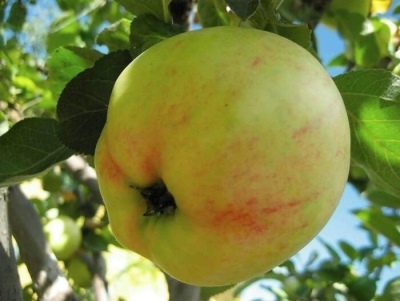
- Authors: Moscow State University M. V. Lomonosov, S. I. Isaev
- Taste: sweet and sour with light spice
- Scent: weak
- Fruit weight, g: 165
- Fruit size: above average
- Yield: up to 160 kg per tree
- Frequency of fruiting: regular
- The beginning of fruiting varieties: for 6-7 years
- Ripening terms: late winter
- Removable maturity: at the end of September
In the Michurinsky Garden of the Timiryazev Academy, tests of apple varieties were carried out, on the breeding of which Russian breeders worked. Over the course of several years, they were evaluated according to several criteria: taste, frost resistance, weight, disease and pest resistance, and yield. As a result of research, the second place was taken by the Moskovskoe Pozdney variety.
Breeding history of the variety
This hybrid variety was bred in the 60s of the twentieth century by fruit breeders of the Lomonosov Moscow State University. The author of the variety is considered to be Isaev S.I. 40 years after the breeding of the Moskovskoye variety. Later, the official zoning took place.
Description of the variety
The apple tree belongs to the late winter varieties. The tree is vigorous, after 5-6 years the height of the tree can reach 6 meters. This complicates the care of the apple tree crown. The crown of a young tree has a wide pyramidal shape. Over the years, the crown changes it to a wide-oval one.
The trunk and main branches are colored green-gray. Skeletal branches are obliquely vertical to the trunk. Brownish-brown young shoots are straight, well pubescent, with short internodes. They are rounded in cross section.
Large ovoid and elliptical leaves with a sharply pointed tip. The edges of the leaves are serrate-crenate. The leaf cover of the apple tree can be characterized as average. The color of the leaves is bright green with a slight gloss that is visible in the sun.
Features, pros and cons
A medium-fruited tree has mostly positive qualities. These include:
high productivity;
long shelf life of fruits;
high frost resistance;
excellent consumer qualities;
good disease resistance.
Only a very dense crown can be attributed to negative qualities.
Ripening and fruiting
The fruits mature at the end of September, during this period the main harvest takes place.
Gardeners get their first harvest in 6-7 years after planting a seedling. Further, the tree gives regular fruiting every year.
The consumer period lasts from late September to May. Almost all year round, buyers delight themselves with wonderful apples.
Growing regions
The variety has gained particular popularity in the Central region of Russia; you can often find it in neighboring regions. Residents of Ukraine and Belarus also grow Moskovskoe Pozd in their gardens.
Yield
Good agricultural care pleases gardeners with the productivity of apple trees. Up to 160 kg of delicious fruits can be harvested from one tree.
Fruits and their taste
The apples are round-conical, have no edges. The aroma is weak, not too pronounced. The size of the fruits is above average, the weight of one fruit can reach 165 g. The smooth skin has poorly visible subcutaneous points. The color of the skin of the ripe fruit is greenish-yellow or golden-yellow, the sides of the apple are decorated with a delicate pink blush.
The white, fine-grained flesh is firm and very juicy.
The apples taste sweet and sour with a slight spice aftertaste.
Tasting score - 4.5 points.
The fruits of this variety contain:
titratable acids - 0.94% (0.70-0.97%);
sugars - 9.29% (8.5-11.3%);
ascorbic acid - 8.8 mg / 100g (7.1-10.5 mg / 100g);
tannins - 55 mg / 100g (41-67 mg / 100g);
pectin substances - 8.7% (6.5-11.3%);
P-active substances - 0.15 mg / 100g (0.12-0.25 mg / 100g).
Fruits for universal use. They are well consumed fresh, suitable for canning.

Growing features
Trees of the Moskovskoye variety are later undemanding to self-care. When choosing a seedling, you need to pay attention to the condition of the trunk. It is desirable that it is not curved. Before planting on the root system, you need to cut off any damaged or damaged roots. Disinfect the cut sites with garden varnish.
For planting, a hole is dug 80 cm deep and 90 cm wide. The bottom of the planting pit is fertilized with humus or compost, then a layer of earth is covered so that the roots do not come into contact with the fertilizer. The trunk is tied to a peg, which is driven in next to it after planting. The seedling is watered with 2-3 buckets of warm water. Watering is very important for trees of this variety. In arid regions and at the time of flowering, the tree needs constant irrigation.
In the second year after planting, it is necessary to begin to form the crown, for this it is necessary to carry out the correct pruning of the shoots.



Pollination
The variety needs pollination. Additional pollinators can be the varieties Vityaz, Zhigulevskoe, Bogatyr and others.
Top dressing
The soil needs to be fertilized twice a season. Rotten manure and mowed grass are excellent remedies for this. In addition, in the spring, it is necessary to feed the trees. For this, gardeners use saltpeter, ash and urea.

Frost resistance
High resistance to frost allows you to grow an apple tree in regions with cold climatic conditions. The variety can withstand frosts down to -27 ° С.

Diseases and pests
The variety is also well adapted to the disease. It is characterized by high resistance to many types of scab.
For the prevention of diseases, the tree needs spraying in the spring.

The apple tree is a popular fruit crop among gardeners. It can be found in many summer cottages. But at the same time, such trees are often affected by various diseases.It is very important to recognize the disease in time and carry out the necessary procedures for a speedy recovery. Otherwise, the fruits will be spoiled, and the tree itself may die altogether.












































































